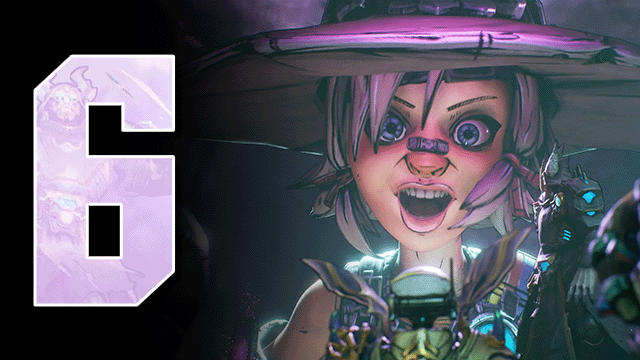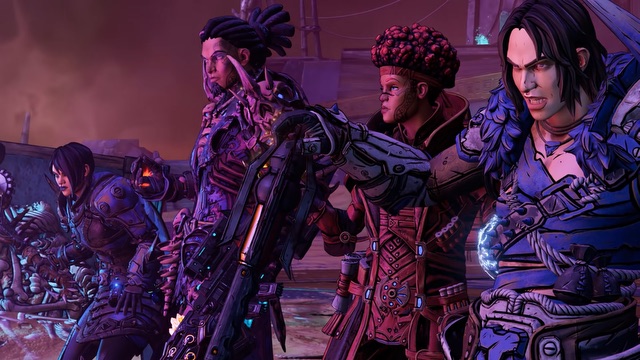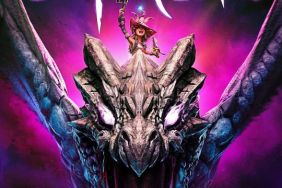Borderlands is a series that’s largely refused to grow with the times. When you put the first and third games next to each other, it’s shocking that there was a decade between them because of how similar they are. So, when Tiny Tina’s Wonderlands was announced, I was intrigued as to whether this spin-off would break out of the mold the series has cast itself in.
Wonderlands is a sequel to the Borderlands 2 DLC Tina Tina’s Assault on Dragon Keep. It revisits the concept of playing a campaign of Bunkers and Badasses (Dungeons & Dragons) with Tiny Tina as the Bunker Master (DM). As such, it has a fantasy motif that stands in contrast to the sci-fi aesthetic of the main series titles. The big question for me was whether or not Gearbox would actually do anything new with the setting, or if it’d play exactly like previous games in the franchise.
Bleakly unfunny
Borderlands is known for its zany sense of humor. In fact, the first sentence of my Borderlands 3 review is, “Borderlands is all about guns, poop, and dick jokes, and you can look forward to a ton of all three of those things in Borderlands 3.” Well, that’s changed.
Tiny Tina’s Wonderlands makes Borderlands 3 look like Blazing Saddles, Airplane!, or Monty Python and the Holy Grail. For some reason, Gearbox decided to make Wonderlands Rated T and completely removed all the raunchiness and violence the series is known for. All that’s left is misjudged irreverent humor and an overall veneer of toxic positivity that makes the game’s writing insufferable.
One scene, in particular, stood out to me as an example of the jarring sweetness hammered into Wonderland. You play the role of a Fatemaker, a hero that is destined to change the fate of the land. You’re trying to make your way to the Dragon Lord’s lair alongside series newcomers Captain Valentine (Andy Samberg) and Frette the Robot (Wanda Sykes). The two get into a very minor argument, and Tiny Tina calls for an honest-to-god vibe check, after which the characters discuss their feelings.
The situation would be funny if it were played ironically, but it’s not. This is coming from Tiny Tina, the character that asked you to find “Mushy Snugglebites” and “Felicia Sexopants” (two rabbit-shaped bombs) their “badonkadonks” so they could stop a train for you by “blowing stuff up and making people die.” Yes, the character who regularly blew people up and wanted to “burn the babies” in previous games now makes people check their vibe if they get into a minor disagreement during a tabletop RPG.
The whole script seems designed by a committee and is full of “heckin’ doggo” type humor about aggressively respecting people’s life choices. Sure, the world has changed even since the release of Borderlands 3 in 2019, and perhaps Tiny Tina’s Wonderlands writers wanted to portray the character in a new, kinder light — however, this doesn’t really work for a game preoccupied with being funny, and the script instead reads like the pleadings of someone desperately afraid of getting canceled on Twitter, with its positivity comes off as performative instead of genuine. It turns out that if you remove the crassness and shock factor from Borderlands’ dialogue, you’re not left with much at all.
Behind the times
The gameplay in Wonderlands is straight from Borderlands. I had hoped that the fantasy setting might see Gearbox emphasizing melee combat or do anything that wasn’t just Borderlands with crossbows, but I had unrealistic expectations. While this tried-and-tested formula is conducive to drop-in multiplayer, when played as a single-player game, it leaves a lot to be desired.
But there are a few changes and improvements. The most drastic change is that instead of grenades, you get spells. These are infinitely more useful than grenades and can do massive damage if you manage to get the right ones to drop. Melee weapons are more useful as well, and you can dual-class after a certain point in the game.
For the most part, though, you’ll be collecting guns and gear of various rarities, keeping the cream of the crop, and selling the rest. Of course, the inventory system still has limited slots. The whole point of this looter shooter is to loot and shoot. When an arbitrary limit prevents you from doing the former, it gets incredibly frustrating. The UI is absolutely horrible, and I hated having to spend five minutes for every 30 or so I played managing my inventory. The game is constantly vomiting up gear, so you’ll drive yourself crazy if you try to take everything. Unfortunately, there’s no auto-loot system, so you’ll spend a good chunk of your time staring at the ground trying to make sure the items you’re picking up are worthwhile.
The actual shooting part is still somewhat fun, but it’s not 2009, and other games do this better now. What Wonderlands really could have used was a crafting system. Strangely, Gearbox hasn’t implemented a way to break down guns and build and customize new ones. You’re constantly getting new level-scaled gear, so buying it from vending machines is pointless. I only sold gear to get it out of my inventory, but having a crafting and upgrade system that made use of excess items would make picking items up worthwhile even in the late game. Instead, several times throughout my playthrough, I had a gun I liked and had to throw it away because there was no way to upgrade it. This is especially annoying when it comes to unique gear that you can’t farm for again.
Progression on a treadmill
Another new addition that comes with Wonderlands is an overworld, which is little more than fluff. In my 30 or so hours with the game, around two hours were spent wandering the overworld between areas in what was an unnecessary waste of time. The game has multiple irritating progression blockers too. You can’t just follow the main story. Instead, you’ll leave an area and find that the one containing your next destination requires you to gain five extra levels lest the basic grunts there rip you to shreds.
Grinding for levels in Wonderlands is tedious, too. You accrue XP incredibly slowly, and the only feeling of progression is that your shooties do a bit more damage and their shooties do a little less, removing the challenge. The game is extremely easy aside from the arbitrary arithmetic that says you’re weak or strong. Enemies don’t display any more advanced behavior or anything; you’re just locked out so you’re forced to do more side content and pad the game out.
Tiny Tina’s Wonderlands Review: The final verdict
https://www.youtube.com/watch?v=0-RAqyHU48M
Wonderlands is the safest, most paint-by-numbers, product-of-the-time game I’ve played in a while, and a serving of the same thing Gearbox has been dishing up for 10 years minus the humor. It’s the absolute opposite of avant-garde and simply reuses the Borderlands formula without improving on it in any tangible manner. While it’s more tolerable as a multiplayer game given that you’ll more readily be able to overlook its story and writing, it’s still a disappointing spin-off that takes away more from the source material than it gives back.
We spent around 30 hours with Tiny Tina’s Wonderlands, completed the main story, a good chunk of side content, and played a bit of the endgame via code provided by PR.
-
Basic gameplay can be fun.
-
Decent premise.
-
Multiplayer can still be a blast.
-
Frustrating progression blocking.
-
Painfully unfunny.
-
Limited inventory space.
-
Terrible inventory UI.
-
At least it doesn't have microtransactions.









